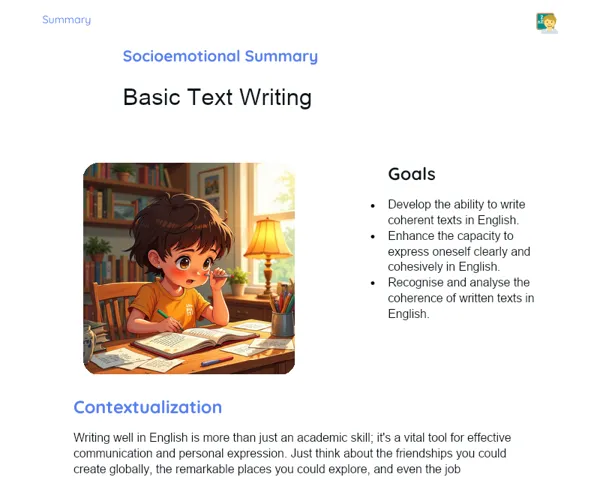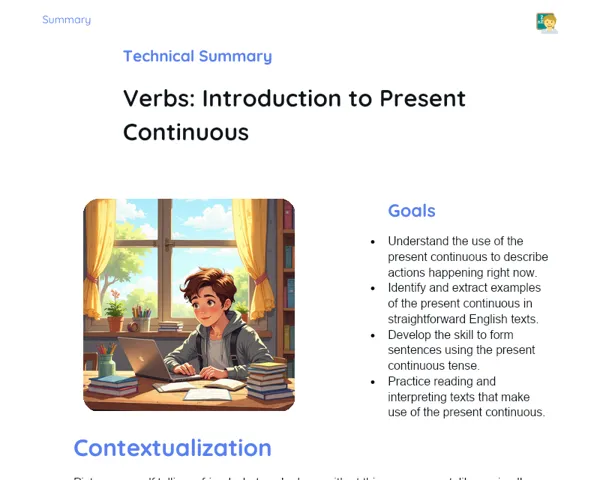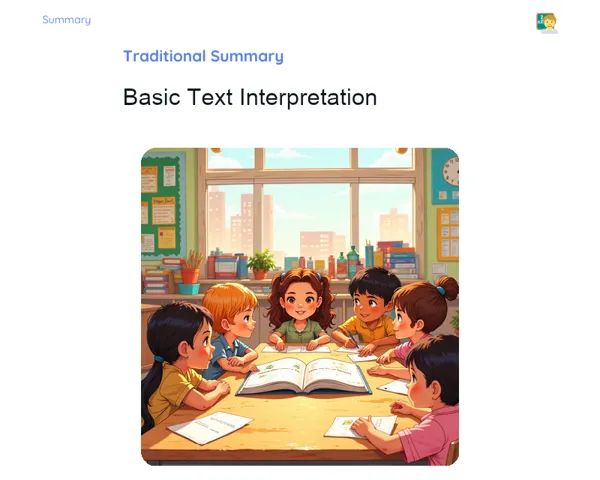Summary Tradisional | Verbs: Can
Contextualization
The verb 'can' is a crucial and adaptable word in English, used to express skills, abilities, and permissions. Similar to how we might use the Afrikaans 'kan' or the isiZulu 'akwazi', in English we employ 'can' to communicate these concepts. For instance, 'Ek kan swem' translates to 'I can swim'. Grasping how to use 'can' enhances your ability to communicate clearly and with confidence in various everyday contexts.
As one of the most frequently used modal verbs in English, 'can' has a unique advantage: it remains unchanged, no matter who is doing the action. This means we don't need to worry about changing its form. For example, 'I can', 'you can', 'he can' – they all use the same structure. This feature makes learning and applying 'can' in different situations much easier.
To Remember!
Affirmative Sentences with 'can'
In affirmative sentences, 'can' expresses skills or abilities, indicating what someone is able to do. The structure for an affirmative sentence with 'can' is straightforward: Subject + 'can' + Base Verb. For example, 'I can swim' translates to 'Ek kan swem'. The base verb remains unchanged.
This simplicity makes using 'can' intuitive, as there's no need to conjugate it for different subjects, which is particularly beneficial for beginners learning English. It reduces complexity and facilitates clearer communication.
Moreover, using 'can' in affirmative sentences strongly aids self-expression, allowing learners to succinctly showcase their skills and competencies. For example, sentences like 'I can draw', 'She can speak English', or 'They can play soccer' highlight what someone is capable of.
-
Structure: Subject + 'can' + Base Verb.
-
The base verb does not change.
-
Facilitates clear and direct expression of skills.
Negative Sentences with 'can'
To form negative sentences with 'can', simply add 'not' after 'can', creating 'cannot' or the contracted form 'can't'. For example, 'I can't swim' translates to 'Ek kan nie swem nie'. The structure for negative sentences is: Subject + 'can't' + Base Verb. Just like in affirmative sentences, the base verb does not change.
Using 'can't' effectively conveys something you are unable to do. This negative form is often employed in casual conversations to indicate limitations or impossibilities. For example, 'I can't make it to the party' or 'She can't drive'.
The contraction 'can't' is popular in informal chats, whereas 'cannot' tends to be more formal. Mastering these forms enhances fluency and precision in English communication.
-
Structure: Subject + 'can't' + Base Verb.
-
Full form: 'cannot'.
-
Expresses limitations or impossibilities.
Interrogative Sentences with 'can'
In questions, 'can' is placed at the start. This is an inversion of the structure used in affirmative sentences. The query structure is: 'Can' + Subject + Base Verb? For example, 'Can you swim?' translates to 'Kan jy swem?'. This interrogative form is used to ask if someone has the ability or permission to do something.
Using 'can' to ask questions is an effective method to gather information regarding abilities and permissions. For instance, questions like 'Can you help me?' or 'Can she speak French?' are common in daily chats. This structure streamlines communication and the exchange of vital information.
Additionally, the interrogative form with 'can' is often utilized in educational and professional settings to check skills and competencies, making comprehension of this structure key for effective English communication.
-
Structure: 'Can' + Subject + Base Verb?
-
Used to ask about abilities or permissions.
-
Facilitates information gathering.
Using 'can' to Ask for Permission
'Can' is also frequently used to ask for or grant permission. In English, it's a casual and straightforward way to request permission for something. For example, 'Can I go to the bathroom?' translates to 'Mag ek na die badkamer gaan?'. The structure for asking permission is similar to that of questions: 'Can' + Subject + Base Verb?
Requesting permission with 'can' is a routine practice in social, school, and work settings. It's a polite, direct way to seek permission without resorting to convoluted language. For example, 'Can I borrow your pen?' or 'Can we leave early?' are typical queries that promote understanding in everyday contexts.
Furthermore, 'can' can also be utilized to grant permission. For example, 'Yes, you can go to the bathroom' or 'You can use my phone'. Familiarity with using 'can' for permission is essential for effective social interactions in English.
-
Structure: 'Can' + Subject + Base Verb?
-
Used to ask and give permission.
-
Facilitates polite and direct communication.
Key Terms
-
Verb 'can': Used to express skills, abilities, and permissions.
-
Affirmative sentence: Structure: Subject + 'can' + Base Verb.
-
Negative sentence: Structure: Subject + 'can't' + Base Verb.
-
Question: Structure: 'Can' + Subject + Base Verb?
-
Permission: Use of 'can' to ask for and grant permission.
Important Conclusions
In this lesson, we explored the usage of the verb 'can' to convey skills, abilities, and permissions in English. We learned how to form affirmative, negative, and interrogative sentences with 'can', as well as how to politely ask for and grant permission. Understanding and accurately applying 'can' is paramount for clear, fluent communication in various everyday scenarios.
The significance of the verb 'can' in the English language is immense. It simplifies communication by not requiring form changes or complex conjugations, making it more accessible to learners, particularly beginners, and allowing students to express themselves confidently about their skills and abilities.
I encourage you to delve deeper into modal verbs and practice forming sentences with 'can' in different contexts. The more you use this verb, the more naturally your English communication skills will develop. Remember that consistent practice is key to achieving fluency.
Study Tips
-
Practice constructing affirmative, negative, and interrogative sentences with 'can' in various everyday contexts.
-
Watch English videos and pay attention to how native speakers use 'can' to express abilities and permissions.
-
Engage in grammar exercises and conversations in English to enhance your understanding and usage of the verb 'can'.



